Earlier this year an announcement landed in my inbox of Canvas, the University Of Wolverhampton’s collaboration tool. It was a call for submissions of articles suitable for the magazine being published for the Faculty of Arts, Business and Social Sciences, of which Photography sits firmly within.
Once I’d quickly skim read the announcement I deleted it without another thought. What’s that got to do with me I thought? Never mind, someone else will volunteer to help out with content.
Only when it appeared again a week later did I think that I might be able to offer something whether it was a photograph of something or a perspective on a subject that I might be able to provide a write up of. I got in touch with the students and staff and began the comms.
In the previous few years I’ve been responsible for producing social media content for the Young Enterprise Shropshire board, after being a board member and a Volunteer Business Adviser. Also as the Press Secretary of the Shrewsbury and District Air Rifle League i’ve produced articles and match write ups, with photos that have appeared in the local newspapers and online in the social media channels. Maybe I could help?
I was added to a Whatsapp group where I introduced myself as a first year photography student then heard from Faye, a first year Animation student, Mary a foundation year Creative and Professional Writing student, Huda doing foundation English Language and Linguistics, and Ellie a first year History and Secondary education student.
Georgia is the editor and I’ve been sending her a couple of articles over the last couple of months.
I’ve submitted a couple of photographs and a book review to the magazine to see if it might help them fill up the pages with varied content.
The First Article
My first submission to the FABSS magazine/newspaper was Bird’s Leg View. A photo taken in the City centre, it included a write up about the photo and also I was asked to submit an artists statement which was tricky to write but was helped by using Gilda Williams’ How To Write About Contemporary Art. I’ll include both parts in the post below here, but the articles will go off to be proofread and edited in the way that best suits the context of the newspaper.
“Bird’s Leg View”
The photo is a black and white image that I made a week ago during an afternoon stroll around the city of Wolverhampton and features the corner of the Wulfrun Centre building. It’s an unusual perspective looking straight up through the concrete channels that appear to float above the heads of the shoppers making their way to and from the outdoor market. The pigeons were airborne too making it obvious that this is taken from the ground looking skywards. I was walking around trying to make photographs of scenes not normally noticed by the everyday pedestrian or motorist.
The ugliness of the concrete that many people recognise, I see as a wonderful structure made up using simple materials combined with ingenious designs. The standard box with windows style of buildings that have been used for centuries are no match in my eyes for the carefully balanced, load spreading, angled architecture that makes up much of the post war modernisation of the UK’s cities and towns.
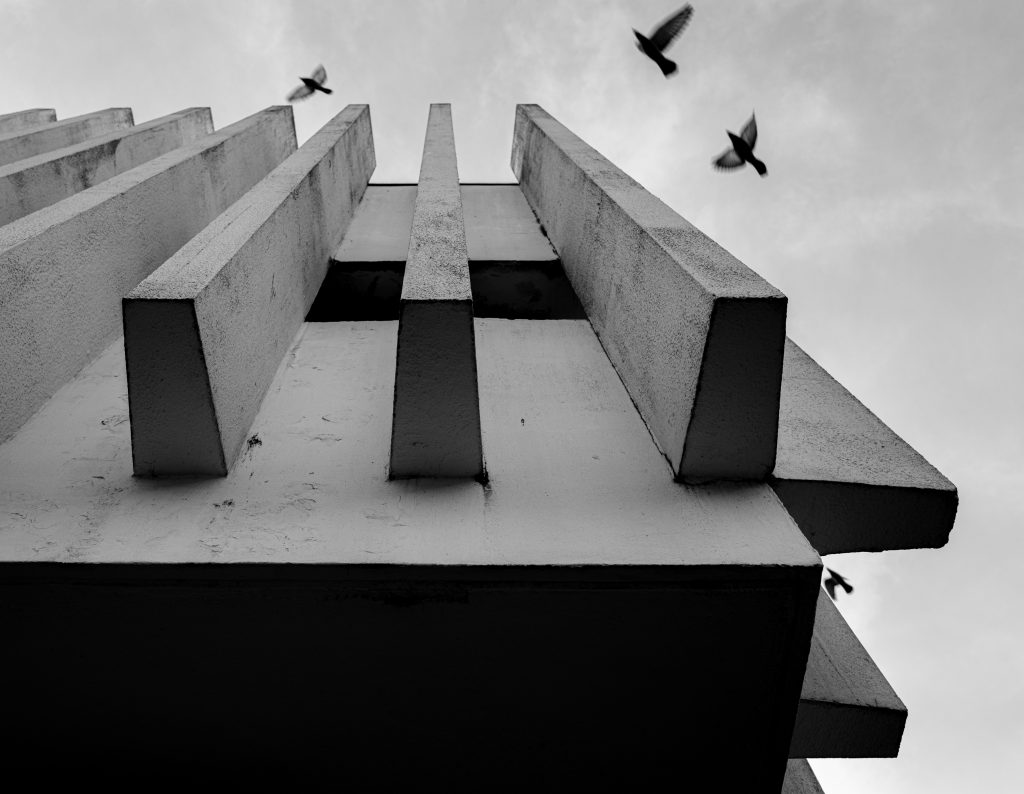
Artist’s Statement – Bob Griffiths
Studying L4 Part time and using digital and film photography to make images that I find intriguing. Photography and making are important parts of my practice. Street photography, architecture, humorous contradictions, family documentary, artistic abstracts and experimental concepts all interest me. Regular expeditions to large cities provide many of my most interesting captures as it’s a world away from my sheltered home town of Shrewsbury. My impostor syndrome lessens with each visit to the School Of Art
A 34 year career in engineering breeds a yearning to understand how everything works, my work often documents places, events, people, and buildings that might otherwise be forgotten in the future. Inexorably drawn to structures and monuments that the wider population find distasteful, I share their mostly undiscovered beauty as if a defence barrister in the court of artistic appreciation.
The hidden beauty in ugliness is my quiet protest against what constitutes “pretty” by the vacuous reality tv shows and false portrayals forced upon the public. Death and decay are sources of beauty that I’m drawn to as they represent the finality of life and act as a memento-mori to remind us of our insignificance in the universe.
Most recently I’ve produced a photo zine based on a Shrewsbury’s multi-storey car park. I share images on my Instagram, maintain a blog and host a YouTube channel containing a diverse range of videos. More details can be found at http://bobgriffiths.uk
The Second Submission
My second submission saw me enter another photograph and a brief write up, I’d also been asked to include a headshot for the newspaper to show who had contributed. The text beneath is the email I sent to Georgia.
“Bin Nevis”
Please find another photograph attached. This one is less about architecture and more about colour and humour. I appreciate that it’s not everyone’s cup of tea so feel free to not use it if you don’t think it’s appropriate. I can dig out some more sensible images if you prefer.
“Bin Nevis”, so called, as my wife and I drove around the North Coast 500 in Scotland last year and visited Fort William to see Ben Nevis, twice. The first it was grey, cloudy, and raining and you couldn’t see any hills. The second time the peak was covered with a single cloud that just would not move on whilst we were there. We’d parked our hired campervan in a small car park, and I noticed that the blue skips led my eye into the image, then wordplay sprung to mind. I love the blue of the skips and the blue of the sky along with the knowing that the summit of the highest mountain in Scotland is hidden behind the cloud.
As a road trip, I’d recommend the NC500 to anyone, starting off at Inverness and travelling North along the coast until John ‘O’ Groats and then anti-clockwise around the coast, over to the Isle of Skye and then back across country to Inverness. It took us eight days, but the scenery was spectacular, from the Cuillin mountains on Skye, to the multiple bridges, lochs and castles that feature on the journey it was outstanding.
I like wordplay and humour in images as it might not be immediately obvious but after a second or two of working it out I find it amusing. Matt Stuart is a great example of a photographer who knows how to see the absurd situations in everyday life and I like to think that his book “Think like a street photographer” has opened my eyes to these types of possibilities.
The link to my website, if you do want to include it is: http://bobgriffiths.uk
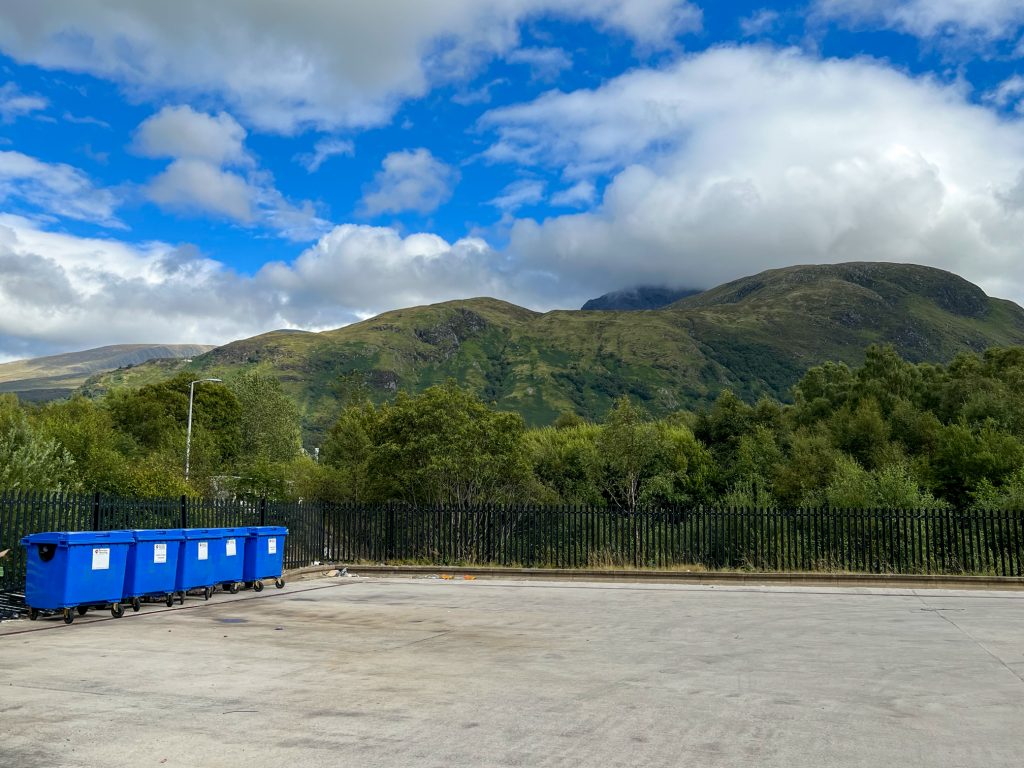
I also attach a self-portrait headshot done as part of a project late in 2022. If it’s not suitable I can reshoot one.
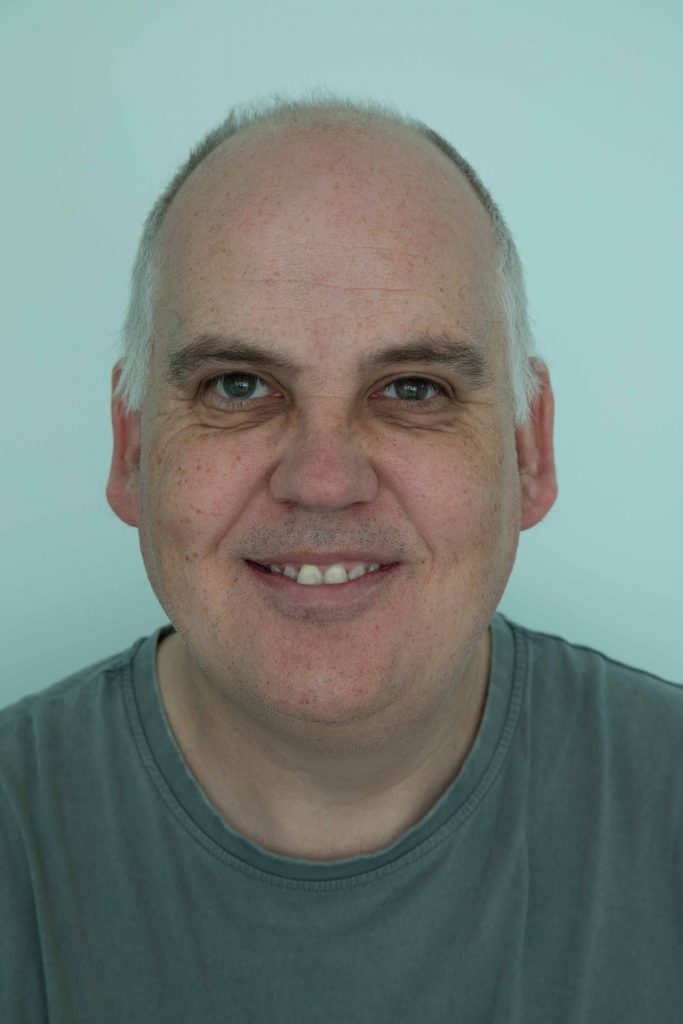
With my mentioning of the Matt Stuart book, would anything like a book review be any use? Or would you rather just have photographs.
The Third Submission
For this piece of content I chose to submit a review of a book, a photo book After Dark by an artist called Liam Wong, it’s been influential to me over the last few months as had his previous book, TO:KY:00. I’ll include the review here too.
Book Review of After Dark by Liam Wong.
Released in the latter half of 2022 this book by Scottish photographer and game designer Liam Wong titled “After Dark” features photographs of cities and urban environments between midnight and morning.
It comes after his debut TO:KY:00 which saw him document the Japanese capital after midnight making entrancing images of romantic scenes, hectic nightlife, and seedy locations. After Dark, published by Thames & Hudson, is an exploration of multiple cities from Osaka, Kyoto, London, Seoul Paris, Rome and more during the night-time hours. It consists of four themed chapters called Society, Alone together, Solitude and Emptiness and whilst this sounds really depressing it really is a truly remarkable collection of photographs made before and during the Covid 19 pandemic. Wong, in his initial introductory note, states that “Everything about the format of the book was designed with cinematic ratios in mind….” and it is obvious just how much his photography uses the language of cinema, evoking sci-fi favourites such as Blade Runner, Total Recall, Ghost in the Shell and other rain-soaked films to name but a few. Wong’s experience and expertise as a designer for video games also explains the images he captures through his camera, each frame could be a still from a cut scene in Cyberpunk 2077, Snatcher and Perfect Dark.
The photos capture often lonely members of society in wonderfully detailed vistas illuminated by neon and led advertising signs and streetlamps. People waiting for trains, cycling home after a long day, and crossing a street whilst holding up an umbrella all lead you into the photo where there is detail galore to digest. The book is 186 pages of pure graphical candy for your eyes to feast on along with text to explain why Wong makes images and sometimes the explanation of a single image to highlight the beauty that many other people have simply walked past without seeing.
It is an inspiring collection of work that I would wholeheartedly recommend for anyone who loves dystopian future and cyber punk aesthetic or even readers interested in different ways to capture the essence of a location without falling into the tourist snapshot trap. It’s available on Amazon and other book retailers for under £30.

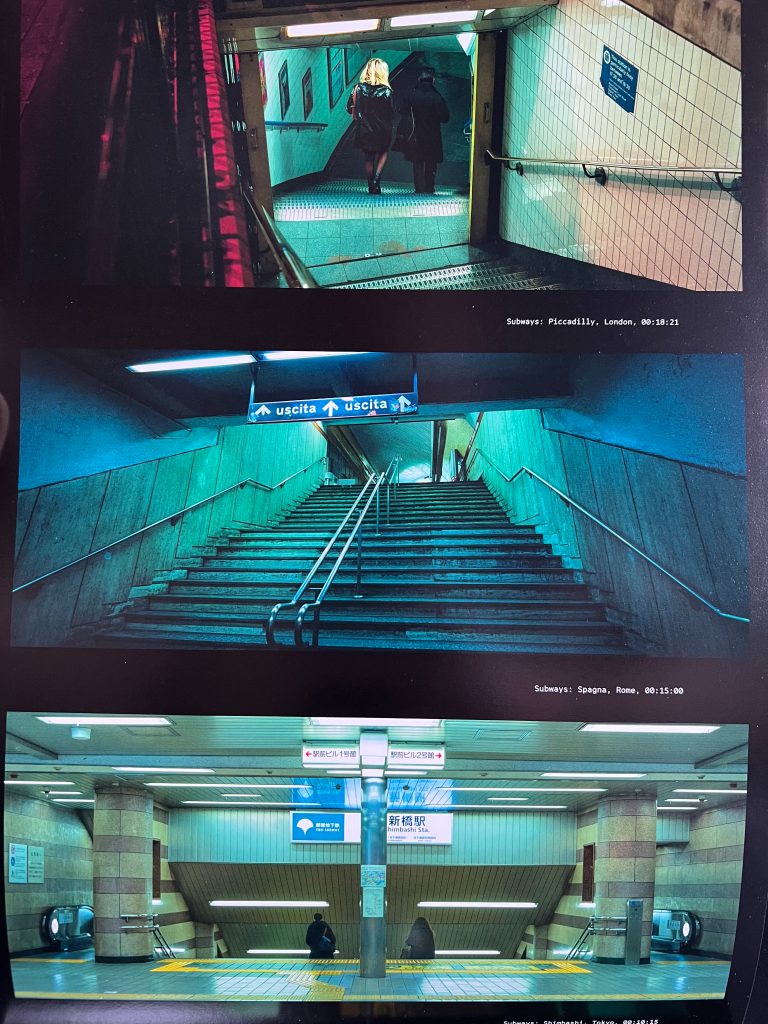

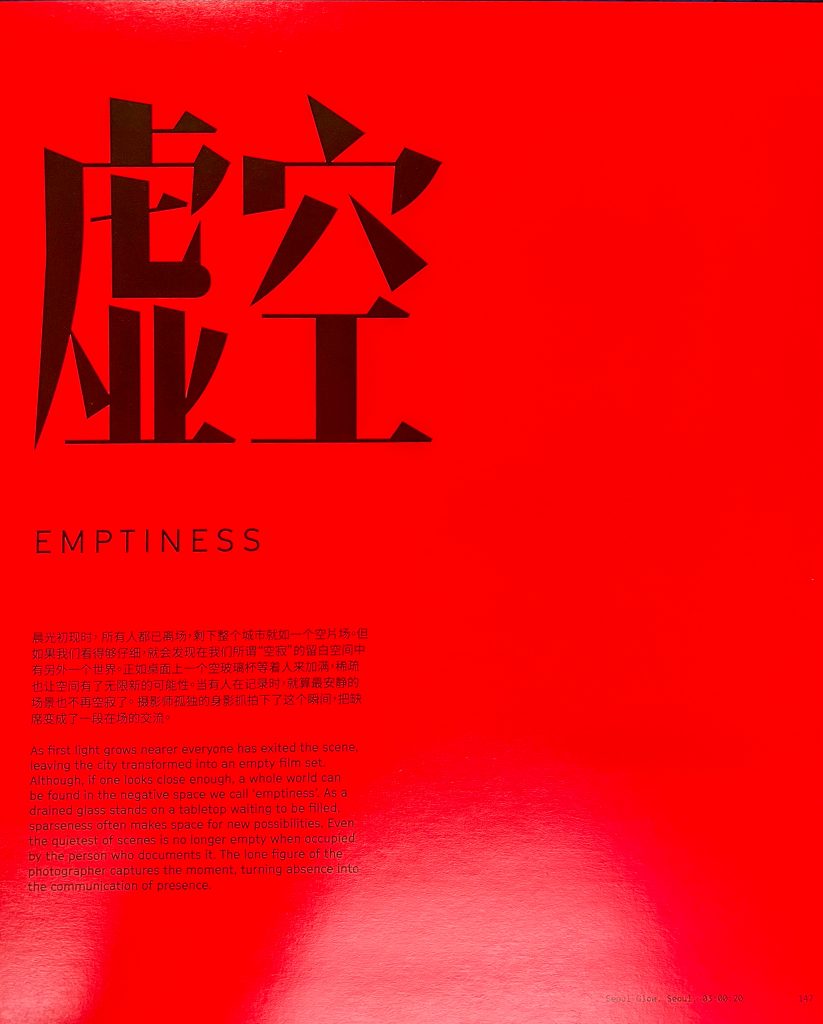
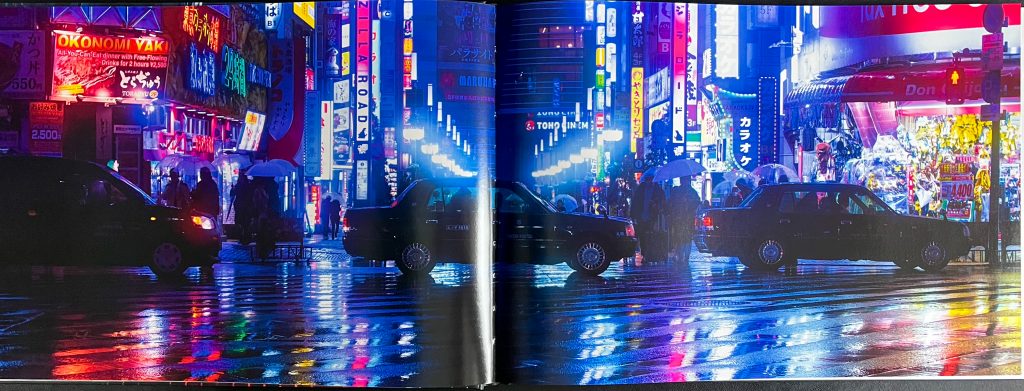
The Fourth Submission
My lecturer Alice sent me an email a week or two after my third submission:
“My colleague Lynn Butler, copied in, is in the process of putting together a new magazine to showcase some of the brilliant work students in our Faculty make.
I was wondering how you might feel about sending Lynn some of your work for your year long project? And a bit of a blurb to go alongside it? An outline of the brief and your response would be fab? Let us know if you’re interested, the deadline for submissions is this week so we would need the content from you quite quickly 🙂 “
Alice Hodgson, March 2023
After checking with Lynn and Georgia I found that the deadline had shifted now to 12th April and the newspaper/magazine will be released on the 17th so there was still time to produce something else. I chose to send in some info about my current year long project along with some images. This can be seen bleow.
Bob Griffiths Photography Year Long Project
This year I started the Experimentation & Dialogues module thinking about damaging photographic negatives and this has progressed throughout the last five months into various other methods of image manipulation. Initially, I didn’t want to destroy any of my valuable negatives so moved into cutting and tearing up paper before printing to them in the darkroom. Using this work, I then started overlaying transparencies of circuit boards and engineering diagrams onto the paper so that it blocked some of the light and merged the two images.

Figure 1
This then changed into joining two darkroom prints together using a weaving process, which I thought at the time was very original. I created two prints in the darkroom and sliced them up with a sharp knife before weaving them together, one piece took seven hours to produce.

Figure 2
Through research I know that this has been done many times before, but the results I got were very interesting to me. I moved on to thinking more about which images I was joining together and used self-portraits and old family photos to create images like the one of both the front and back of my head simultaneously.

Figure 3

Figure 4
Further research followed on jigsaws, folding, and scrunching paper and then printing onto them from negatives. I still hadn’t damaged any negatives but then unfortunately dropped my 35mm film camera into a deep puddle. The photos I got from my rescued and dried out film were intriguing, with organic looking damage that seems to work well with the content of the images. These were then used to mix multiple images together.

Figure 5
From using negatives, paper, and film I started to experiment digitally with images and merging photos together using masks and chequered patterns to join images that were linked in some way. Some images of my childhood days are merged with recent photos of the area where I lived at that time.

Figure 6
My most recent experiments have been using Barrier-Grid methods to reveal/conceal parts of images using a transparent film to move around, this was a result of talking to Niki about a book (Vento by Virginia Mori) in her collection that used this method to animate images.
This year’s work is very unlike my usual practice as I’m normally a straightforward street photographer with interests in architecture, people, transport, and long exposure images.
This weaving, merging, and damaging was happening without knowing why I was attracted to it. Talking with my tutors Niki and Alice, they helped me to understand that my 34 years working in engineering might be helping to drive this deconstruction and reassembly of images. I’ve always liked to understand how things work and take things apart to learn, so this direction in my work should not have been a complete surprise. It has begun to make sense as to why I’m doing this work and I continue to use the skills and thought processes learned this year to continue moving forward as I get closer to submission in May. My online blog serves as my Reflective Journal and Sketchbook, showing my thought processes and details of other experiments and trials. It’s available at http://bobgriffiths.uk
How Does This Help Me?
This is a good question. With a great answer. It helps me in all sorts of ways.
Firstly it helped me with learning to write an artist statement, something that was tricky to do and helped by researching. I’ve got something I can use for the future and an ability to tune it for the context it will be used in.
Selecting images to submit for the newspaper/magazine was also a tricky affair. I didn’t want to submit a completely random image so felt it needed to be Wolves relevant. I have a few images from around the uni and the city but didn’t want to keep everything uni based. People might want to see something from outside their study location. The image of Bin Nevis was a good one when I made it in 2022 but never felt like I could use it for anything other than a funny insta post. Submitting it to this magazine felt like it could be treated as if it were one of the clever street photography images like Matt Stuart produces. It wasn’t easy to select my own images and talk positively about them, it doesn’t come naturally to me and is outside of my comfort zone. Impostor syndrome was triggered a little bit with this particular photo.
Writing short concise articles, (not like this blog) is also a tricky thing to do but will ultimately aid my academic writing with column inches being a premium, selection of the relevant info was also difficult and important.
Networking with other students, and staff members of the University can only be a good thing if I get it right. I hate the term “networking” but building up a connection to people around the student/staff might help with getting a good reputation as someone who can be relied upon, or even lead into jobs in the future. Again, my comfort zone is being stretched with this type of collaborating with other artists and staff but it feels good to have links with others.
Another benefit of being a part time student is being here for the six years and whilst it means I have to shift groups every year or two, the number of students I mix with is growing. Take this year as an example, I am still L4 and classmates from last year are now L5 and the then L5 now being L6. I’ve got a large number of people I can talk to when I’m in the basement or round and about where most of these people stay in the same year group for the three years, I consider myself lucky.
Alice sending me the email about sending in information about my Year Long Project was also very nice to receive. To me it means that she thinks it’s worthy of telling people about and confirmation to me that the work I’ve put into it thus far is being appreciated. Not that I do the work for that reason, as stated in the previous post, but it is a reinforcement of the positive effect of hard work and commitment.
I’m looking forward to seeing what gets published, what gets trimmed out and what bits are cut in the editing process and to see if my work gets some good exposure. I don’t doubt that others will see it but it may not be a very impactful body of my work but I can at least look upon it as being published. My CV will benefit from this and it may well help (or possibly hinder) my work prospects in the future should I decide to leave my full time job to move into art and photography.
[…] with and some of these are now complete and can be seen in some of the related posts: print club, FABBS magazine, Black Country Type Photowalk, SpacePlay Volunteering, Riso Printing, Ilford competition, and […]